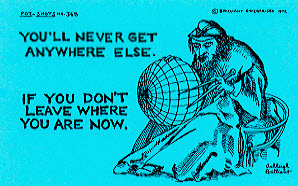This third-in-the-series post is the last of the initial mind-set sequence. It’s important because it sums up the systems mindset as a package and then rolls through the systemizing process in a step-by-step overview. The next several posts of the series will include more specific information and detailed suggestions.

For a small business, what is the most virulent strain of self-deception? The business owner’s conviction that one must work long and hard in order to find success. Maybe this is why grueling long hours and constant frustration are nothing unique. Too many leaders work to physical and mental exhaustion not understanding that the hard work itself is a distraction from seeing and then doing the leadership chores that will actually produce a relaxed life of freedom and success.
In running your business what is the alternative (and the cure)? Very simple. See your business as a dispassionate machine that is separate from yourself and then make it hyper-efficient via relentless system improvement of the subsystems within the business.
Your business isn’t you. It’s a machine.
Make your workplace mechanically efficient and you’ll be in select company. Stick with it and begin replacing the disorder with order, and you’ll leap ahead of the competition.
Be sure to take a moment to check out the “crazy traffic” video near the end of this post. Does it depict your business?
So your long hours can be worse than useless as they distract you from establishing the mental stance that will lead to tangible freedom. (The two critical components of freedom? Lots of time and lots of money.)
Yet again: You don’t want your operation to be you. Let’s make it a machine; a separate entity with a goal of it’s own.

The day you see your business, personal life and health as a mechanical collection of linear systems and not an emotional conglomeration of swirling sights, sounds and events, is the day everything changes. On that day, when you “get it,” you’ll instantly turn into a mechanic and go about adjusting sub-systems until you, with delicious satisfaction, watch those perfected systems coalesce into exactly the life you’ve always imagined.
Experiencing this; making this happen, is borderline spiritual.
There is no reason to wait! The point-of-sale management style means make things happen NOW. As you read through the following points, think about instant implementation.
The following points are what I carry in my head from moment to moment. I recommend you:
- Do this today, this moment: Renounce holism as a process. Instead, make it a goal, a goal you attain by paying attention to the pieces of the machine, always working to make each piece perfect.
- Know without any doubt that your life is made up of independent linear systems and that 99.9 percent of them work just fine. (See chapters four and five in my book Work the System). This means there isn’t that much to fix.
- Embrace the boring-but-true fact that documentation makes your system improvements permanent. Make documentation front-and-center. A critical part of your leadership job is to convince your staff that creating it is a smart thing to do.
- One at a time, analyze each system. Start with the most problematic. On paper, describe how each system executes. These are Working Procedures.
- Assertively seek advice from the people you manage. Forget top-down when it comes to system improvement. It’s bottom-up. (See chapter 8, pg. 90.)
- Tweak the working procedures to perfection. Then, manage them to produce the results you want. Stop spending your time fixing the bad results of unmanaged systems. Manage your systems and get the results you want! This is how successful people operate.
- Distribute your documented system protocols to your staff and make sure the protocols are followed exactly. Assure your people that, for any system procedures, you will instantly consider their suggestions and that if the advice is good, you will instantly insert those suggestions into the procedure. The singular goal is to improve the steps and sequences of the individual systems until they are perfect.
- Keep the collection of documented systems at hand, readily accessible to everyone. We have created software for that.
- Get everyone on board. If there are hold-outs to your new documentation and procedural efforts, you have a simple choice: These people must embrace the new strategy or they must leave. You must surround yourself with people who share your vision. (How to get your staff to climb-on-board? It’s easy. See chapter 11, pg. 118.)
- Grease the wheels by constantly encouraging your staff to see everything as either part of a system or the outcome of a system. By perceiving things in that way, regular maintenance and updating will make sense and will actually occur….
- Will you still be the boss? Oh yeah! More so than ever. In business, the benevolent dictatorship is what works. There must be a strong, decisive leader, and that’s you.
And what do you get? A holistic result. A business where all the parts are working smoothly, profitability is great, and the people who help you make it all happen are happy.
Oh. And your life gets dramatically easier: lots of time. Lot’s of money. It’s the life you’ve dreamed about.
How do you make the transformation? Many have done it on their own with my book (see testimonials), but many, many more have started and then soon failed. What is the largest barrier to getting a business systemized? By FAR, it’s simple procrastination by the owner. There’s the “I haven’t got time,” and the, “exactly where do I begin?” excuses. (These two challenges comprise 90% of the reason there is a “failure-to-launch.” The other 10%? Ownership in-fighting which is a structural problem that may not be fixable.)
So, here’s the “traffic video*” I mentioned earlier. Is this your business and your life?
I’m just sayin’…
So, to successfully systemize a chaotic business, there’s work to do and particular steps that must be taken. It’s a challenge. Here are some resources we offer to help you make it happen. One is the Work the System Academy, our online training product. Another is our Transformational Group Coaching with my WTS Consultants business partner Josh Fonger. Also, Individual one-on-one coaching, with Josh (use the same link as Group Coaching). And, if your sales are 10M and over, there’s full-blown individual Premier Consulting, with Josh (and sometimes, me).
Here’s your homework:
1. Re-read chapters four and five in my book Work the System. (Get it here on this website, for free in PDF or audio. Or, get the hard-copy.)
2. If you haven’t read the previous posts in this “Obsess” series, catch up! I’ve carefully composed them to be in sequence. Be sure to start with the Introduction.
Ten Concepts That Obsess Me Now
Introduction
Part 1, Point of Sale
Part 2, Critical Thinking Search and Rescue
Part 3, A Business is a Dispassionate Machine
Part 4, Hyper-Efficiency Via Total Inbox
Part 5, Emailed Voice Mail (EVM)
Part 6, Thinking Slow, Moving Fast
Part 7, Deal Killers and the Main Machine
Part 8, The Simple Key to Double Sales and Create Raving Fans
Part 9, The Tail Wagging the Dog Syndrome
Part 10, Do You Have Quiet Courage?
Illustrated epigram by Ashleigh Brilliant. www.ashleighbrilliant.com
Photo by h.koppdelaney via flickr used under a creative Commons License.
*Video location is Meskel Square, the nerve center of Addis Ababa, Ethiopia.
